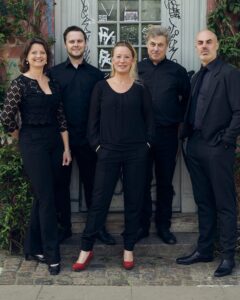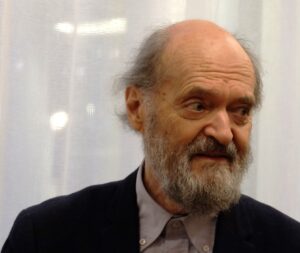Barok od kuchni
Dzisiaj post na rozgrzewkę – po gwałtownym ataku zimy na wiosnę. Przypominam recenzję napisaną wkrótce po wydaniu nietypowej książki kucharskiej Beaussanta (pod polskim tytułem Barokowa melokuchnia nie tuczy), którą wciąż mam w księgozbiorze i którą niezmiennie lubię – mimo pewnych zastrzeżeń. Za kilka dni relacja z Moguncji, a tymczasem do rondla! A przynajmniej do lektury, zwłaszcza że czasy się zmieniły i Czytelnicy mogą bez większego kłopotu nabyć ten drobiazg w którymś z internetowych antykwariatów.
***
Gdybym zobaczyła tę książkę w księgarni, ominęłabym ją szerokim łukiem, zniechęcona polską wersją tytułu i opracowaniem graficznym (jeszcze do tego wrócę). Na szczęście (?) książki tej w księgarniach raczej nie uświadczysz: nakład rozszedł się jak woda dzięki doskonale zorganizowanej promocji, w której uczestniczyli między innymi Jan Gondowicz i Tessa Capponi-Borawska, postaci znane odpowiednio w świecie literatury i sztuki kulinarnej. Informację o jej wydaniu dostałam pocztą elektroniczną od Piotra Kopszaka, znawcy XIX-wiecznego malarstwa polskiego i melomana, a zarazem pomysłodawcy przedsięwzięcia. Zwalczyłam więc opory natury językowo-estetycznej i nie żałuję.
Książeczka Philippe’a Beaussanta, francuskiego muzykologa i pisarza, założyciela Centre de Musique Baroque de Versailles, nazywa się w oryginale Mangez baroque i restez mince, czyli w wolnym przekładzie Jedz obficie i nie tyj, choć – rzecz jasna – nie sposób zlekceważyć, że owa obfitość ma wymiar „barokowy” i zawiera w sobie pewną dwuznaczność. Beaussant proponuje nam niezwykle osobistą książkę kucharską, nawiązując stylistycznie do największych mistrzów gatunku, z Brillat-Savarinem na czele. To nie tylko przewodnik kulinarny, ale przede wszystkim perełka literacka, osadzona w kontekście muzyki barokowej. Autor chwali się własnymi umiejętnościami, cytuje przepisy pani Couperin, układa jadłospisy na wzór zbiorów kompozycji klawesynowych mistrza François, zagląda w garnki zaprzyjaźnionym wykonawcom muzyki dawnej. Wszystko to w gęstym, lecz smakowitym sosie dygresji na tematy geograficzne, dialektyczne i kulturowe, podanych językiem bliższym metaforyce recenzji koncertowych niż dzieł z zakresu dietetyki – w słusznym przeświadczeniu, że sztuka ingrediencji jest równie ulotna i trudna do opisania, jak sztuka dźwięków.
Scena w kuchni. Malarz nieznany, Hiszpania, ok. 1610-25. Museum Boijmans Van Beuningen w Rotterdamie
Mile zaskakuje różnorodność tych wariacji, skrzących się dowcipem w przepisach własnych („Gdy dojdziesz do głąba, grubego na dwie pięści, tnij bezlitośnie. Włóż w to miejsce farsz, odpowiednio ugnieciony w kulę i, liść po liściu, ubieraj z powrotem swoją kapustę, tak jak ją stworzył Wielki Mistrz Wszechświata; ale ponieważ brak ci Jego zręczności, musisz się zaopatrzyć w kawałek cienkiego sznurka po to, by wszystko przyzwoicie się trzymało.”), imponujących erudycją w analizach XVII-wiecznych obyczajów kulinarnych, wzruszających intymnością i radością dzielenia się rozkoszami stołu w części poświęconej „kuchni tych, co kochają barok”, między innymi Malgoire’a, Christiego, Goebla i Savalla. No właśnie, wielbiciel wykonawstwa historycznego może się poczuć rozczarowany nieobecnością wschodzących gwiazd wśród rozmówców Beaussanta, trzeba jednak pamiętać, że książeczka ukazała się we Francji pod koniec XX stulecia. W dziejach interpretacji muzyki barokowej to wieczność, w dziejach sztuki kulinarnej – okamgnienie. Próba odtworzenia nieśmiertelnych recettes we własnej kuchni może się jednak odbywać przy akompaniamencie dawnych, trochę już zapomnianych nagrań. Smakowite i pouczające.
Tłumaczka Krystyna Kamińska celnie oddała jędrny, a zarazem kwiecisty styl Beaussanta. Zachowała też wszelkie odmienności w opisach przyrządzania potraw, świadczące nie tylko o temperamencie, ale i stopniu wtajemniczenia smakosza w arkana sztuki kulinarnej. Jeśli w przepisie na deser turinois pojawia się 100 gramów masła i 100 gramów czarnej czekolady, wolno podejrzewać, że lutnistka Claire Antonini jest w kuchni raczej odtwórczynią niż kompozytorką. W przeciwieństwie do Fabia Biondiego, który wyjaśnia ze znawstwem, że „rodzynki odbierają sardynkom to, co mają one w sobie agresywnego, cytryna dodaje pikanterii, której im brakowało (…)”. Sybaryta Paul van Nevel woli się oddać w ręce specjalistów i zabiera nas w podróż po najlepszych kuchniach Europy. Ton Koopman okazuje się równym nudziarzem talerza, jak klawiatury – tak przynajmniej wnoszę z opisu jego ulubionej zupy pomidorowej.
Annibale Carracci, Chłopiec pijący wino, ok 1582. Christ Church, University of Oxford
Moim zdaniem warto wypróbować większość zawartych w książce recept, zwłaszcza te, które dają kucharzowi najszersze pole do popisu (można je rozpoznać po sformułowaniach „jeśli chcesz”, „według upodobania” lub „do smaku”) i wymagają od niego pewnej dozy okrucieństwa (np. kapłon z ostrygami, piramida z raków albo młode gołąbki à la William Christie). Moja babcia łapała winniczki w Lasku Bielańskim, po czym kazała im „czyścić się” przez tydzień w siatce zawieszonej pod sufitem, po raki chodziła na targ, podkarmiała je i polewała wodą, by potem w milczeniu wysłuchiwać ich przedśmiertnych pisków we wrzątku. Stępiwszy we mnie dziecięcą wrażliwość, nauczyła mnie gotować i smakować potrawy przyrządzone przez innych. I jakimś cudem nie tyć, co wiąże się w znacznej mierze ze stylem życia, zalecanym także przez Beaussanta, który nie próbuje przekonywać czytelnika, że zachwalane przezeń smakołyki są niskokaloryczne i lekkostrawne.
Tłumaczka nie ustrzegła się drobnych błędów, przeinaczeń i niedopowiedzeń, z których najpoważniejszym jest propozycja „kaczki po barbarzyńsku w okrutnym mentolu”. Canard de barbarie to hodowlana odmiana zamorskiej kaczki piżmowej (taka czarno-biała z łysym czerwonym łepkiem), którą Jos van Immerseel i Claire Chevalier każą nadziać aromatycznymi listkami mięty, nie zaś – jak można wnosić z tytułu – pastą do zębów. Tajemnicza „kasza pil-pil”, z którą należy ją podawać, to drobna kaszka z pszenicy kamut, którą w polskich warunkach można z powodzeniem zastąpić kuskusem. Persimmon to po polsku persymona, w sklepach dostępna częściej pod nazwą sharon niż kaki, i nie jest to żaden kuzyn hebanu, tylko owoc pewnej rośliny z rodziny hebankowatych, z której drewna się akurat nie pozyskuje, w przeciwieństwie do innych drzew z rodzaju Diospyros, przede wszystkim hurmy hebanowej, będącej cennym źródłem ciemnego, trudno łupliwego hebanu. Pisząc o boćwinie, warto wyjaśnić, że nie chodzi o botwinę, czyli młode zielsko buraka ćwikłowego, tylko o przepyszne liście buraka liściowego, w kuchni polskiej prawie całkiem nieznane (a szkoda). To jednak drobiazgi, które prawdziwego miłośnika dobrej kuchni nie odstraszą.
Martwa natura z salami, pieczywem i szklanymi butelkami, druga połowa XVII wieku. Nieznany malarz z regionu Emilia-Romagna. Zbiory prywatne.
Odstraszyć mogą za to brzydka i nieczytelna okładka, niewygodny format (książka kucharska musi się lekko rozkładać, żeby można było do niej zerkać podczas gotowania i przy tym jej nie upaprać) oraz słabiutka typografia. Projektowanie książek jest dyscypliną trudną i odrębną, którą amatorzy zajmować się nie powinni. Drobiazg? Zacytujmy więc anegdotę Beaussanta o Ansermecie, który „każe muzykowi powtarzać w nieskończoność ten szczegół, by go dopracować. Trwa to długo. Wreszcie dyrygent i instrumentalista uzyskują to, o co mu chodziło. Ansermet tłumaczy się przed orkiestrą. «Tym bardziej, dodaje, że w orkiestrze nie będzie tego nawet wcale albo tylko trochę słychać…» Zatrzymuje się i mówi dalej: «Tak, ale Bóg to usłyszy. Dziękuję»”.





